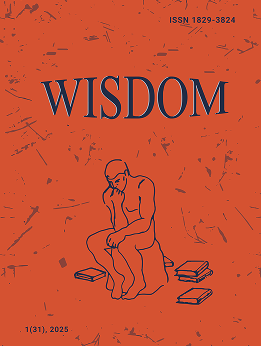Gender Markers in the English Picture of the World
DOI:
https://doi.org/10.24234/wisdom.v19i3.506Keywords:
gender, gender marking, phraseology, idiom, picture of the world, colour nameAbstract
Gender is determined as an ideological frame that assembles the idea of what it means to be a man or a woman in a certain culture, a non-linguistic category with linguistic ways of actualization. The article substantiates the key theoretical problems concerning gender-marking based on English phraseology and their influence on the formation of the gender picture of the world.
The objective of the current paper is to analyze gender-marked phraseological units of the English language, which are the basic matrices of the phraseological picture of the world of a given cultural community, and to identify the frequency and impact of gender stereotypes on the development of the national picture of the English-speaking community, such as word, phraseology, paremia, text, which contain background knowledge and ways to reflect these meanings in the national picture of the world.
The paper’s main conclusion is that the semantic basis of gender markers on the material of English phraseological units predominantly consists of stereotypical-associative units, which are perceived as social activity and characteristics of the images of both sexes with certain asymmetry for male denotata. The connotations of words can illustrate this inequality and the double standards between men and women.
Downloads
References
Audring, J. (2016). Gender. Linguistics. Oxfrord: Oxford University Press. https://doi.org/10.1093/acrefore/9780199384655.013.43
Corbett, G. G. (2012). Number of genders. The World Atlas of Language Structures Online. Leipzig: Max Planck Institute for Evolutionary Anthropology. Retrieved from https://wals.info/chapter/30
Goethe, J. W. (1964). Izbrannye filosofskie proizvedeniya (Selected philosophical works, in Russian). Moscow: Nauka.
Hrabiichuk, M. V., & Lazebna, O. A. (2020). The concept of ìgenderî in the modern scientific paradigm. Young Scientist, 6(82), 369-372. Retrieved from http://molodyvcheny.in.ua/files/journal/2020/6/73.pdf
Humboldt, W. von. (1984). Izbrannye trudy po yazykoznaniyu (Selected works on linguistics, in Russian). Moscow: Progress.
Humeniuk, I. (2020). Philosophy of red color: Linguistic and extralinguistic aspects. Wisdom, 15(2), 188-198.
Kirilina, A. V. (1999). Gender: lingvisticheskie aspekty (Gender: Linguistic aspects, in Russian). Moscow: Institut sotsiologii RAN.
Kunin, A. V. (2005). Kurs frazeologii sovremennogo ruskogo yazyka (Modern English phraseology course, in Russian). Dubna: Feniks+.
Lakoff, R. T. (2004). Language and womenís place: Text and commentaries. Oxford: Oxford University Press.
Lukach, M. (2014). Komponentnyi analiz yak metod doslidzhennia semantyky diiesliv ukrainskoi movy (Component analysis as a research method for semantics of verbs in the Ukrainian language, in Ukrainian). Studia Methodologica, 38, 150-155. Retrieved from http://dspace.tnpu.edu.ua/bitstream/123456789/6301/1/Lukach.pdf
Malyshevskaya, D. Ch. (1999). Bazovye kontsepty kulítury v svete gendernogo podkhoda (na primere opozitsii ìMuzhchina/Zhenschinaî (Basic concepts of culture in the light of a gender approach (on the example of the opposition ìMan/Womanî). In Frazeologiya v kontekste kulítury (Phraseology in the context of culture, in Russian) (pp. 180-184). Moscow: Shkola ìYazyki russkoi kulturyî.
Martyniuk, A. P. (2004). Konstruiuvannia gender v anhlomovnomu dyskursi (Constructing gender in English discourse, in Ukrainian). Kharkiv: Konstanta.
Milton, D. (2002). Sex and gender are different: Sexual identity and gender identity are different. Clinical Child Psychology and Psychiatry, 7, 320-335.
Morozova, N. N. (2002). Gendernye problemy vo frazeologii. Frazeologiya i miroponimanie naroda. Frazeologicheskaya kartina mira (Gender problems in phraseology. Phraseology and world outlook of the people. Phraseological picture of the world, in Russian). Tula: Tula State Tolstoy University.
Okaley, A. (1972). Sex, Gender and Society. London: Temple Smith.
Rubin, G. (1975). The traffic in women: Notes on the ìpolitical economyî of sex. In R. R. Reiter (Ed.), Toward an Anthropology of Women (pp. 157-210). New York: Monthly Review Press.
Stavytska, L. O. (2003). Mova i stat (Language and gender, in Ukrainian). Krytyka (Critics, in Ukrainian), 6, 29-34.
Stoller, R. J. (1968). Sex and gender; on the development of masculinity and femininity. New York: Science House.
Tannen, D. (1990). You just donít understand. Women and men in conversation. New York: William Morrow & Co.
Telia, V. N. (1996). Russkaya frazeologiya v zerkale natsionalínogo mentaliteta (Russian phraseology in the mirror of the national mentality, in Russian). Moscow: Shkola ìYazyki russkoi kulíturyî.
Terner, V. (1987). Simvol i ritual (Symbol and ritual, in Russian). Moscow: Nauka.
Yatsymirska, M. (2002). Mova suchasnoi ukrainskoi presy: stan i tendentsii rozvytku (The language of the modern Ukrainian press: The state and trends of development, in Ukrainian). Visnyk lvivskoho natsionalnoho universytetu (Bulletin of Lviv National University, in Ukrainian), 22, 48-54.
Zykova, I. V. (2001). Spetsifika gendernoi markirovanosti angliiskikh idiom (Specificity of gender marking of English idioms). Gender: yazyuk, kulítura, kommunikatsiya (Gender: Language, culture, communication, in Russian), 1, 150-159.
Zykova, I. V. (2003). Sposoby konstruirovaniya gendera v angliiskoi frazeologii (Methods for constructing gender in English phraseology, in Russian). Moscow: Editorial URSS.
Downloads
Published
How to Cite
Issue
Section
License
Copyright (c) 2021 Author and scientific journal WISDOM

This work is licensed under a Creative Commons Attribution-NonCommercial 4.0 International License.
Creative Commons Attribution-Non-Commercial (CC BY-NC). CC BY-NC allows users to copy and distribute the article, provided this is not done for commercial purposes. The users may adapt – remix, transform, and build upon the material giving appropriate credit, and providing a link to the license. The full details of the license are available at https://creativecommons.org/licenses/by-nc/4.0/.















